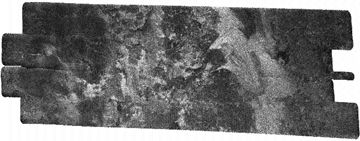 In late
October, the synthetic aperture radar on the Cassini-Huygens spacecraft penetrated
Titan's thick, orange atmosphere of organic smog and captured images of the
surface, revealing features that resemble lava domes and lava flows. Such features
may be evidence of a geologic process that shaped — and possibly continues
to shape — Saturn's largest moon, which is one of the most likely sites
for extraterrestrial life in our solar system.
In late
October, the synthetic aperture radar on the Cassini-Huygens spacecraft penetrated
Titan's thick, orange atmosphere of organic smog and captured images of the
surface, revealing features that resemble lava domes and lava flows. Such features
may be evidence of a geologic process that shaped — and possibly continues
to shape — Saturn's largest moon, which is one of the most likely sites
for extraterrestrial life in our solar system. This radar image of the surface of Saturn's moon Titan, acquired on Oct. 26 by the Cassini spacecraft, shows a complex geologic surface thought to be composed of icy materials and hydrocarbons. Brighter areas may correspond to rougher terrains, and darker areas are thought to be smoother. Courtesy of NASA/JPL.
The seemingly volcanic features could confirm the existence of cryovolcanism — a volcanic process involving icy fluids, or cryo-lavas, that is widely suspected to exist on many frozen bodies in the solar system. Cryolavas consist of water or water-ammonia fluids that, on Titan, would flow like basaltic lavas do on Earth.
Cryovolcanic features make Titan "a lot more astrobiologically interesting," says Ralph Lorenz of the University of Arizona, a member of the Cassini radar team. The interaction of water or ammonia-water with organic compounds on the moon's surface, he says, could produce amino acids, the building blocks of life.
Additionally, Cassini's radar images distinctly lack evidence of impact craters — possible evidence for active cryovolcanism. "What is a rather big surprise is that we don't see much that we are confident is impact-related," says Randolph Kirk, a geophysicist with the U.S. Geological Survey's Astrogeology Team in Flagstaff, Ariz. "This means the surface of Titan is geologically young and must be quite active."
Geologic activity requires heat, and although surface temperatures on Titan are roughly minus 300 degrees Fahrenheit, researchers believe Titan's interior may still provide enough heat to partially melt the frigid slurry of ammonia-water and rock that is expected to comprise the subsurface. The melting temperature of ammonia-water is only minus 143 degrees Fahrenheit.
Researchers, however, caution against any premature verdicts. "We see a lot of features in the images and don't have firm conclusions about the nature of just about any of them," Kirk says.
Still, two types of features may be cryovolcanic in origin. The first is a large quasicircular feature, about 80 miles across, which appeared in an image taken on Oct. 26 from 745 miles above the surface. "This bears at least some resemblance to steep-sided domes seen on Venus by Magellan," Kirk says. If so, he says, the feature may have formed from an eruption of thicker cryolavas. But scientists have no topographic data yet for this region, making it difficult to discern from shading alone whether the feature is a dome or a crater. "Without knowing if the circle is an 'innie' or an 'outie,' it's hard to proceed further," Kirk says.
Another image taken on Oct. 26, but from 1,553 miles above Titan's surface, reveals a second potential cryovolcanic feature. "It appears to be positive relief," based on the brightness of the feature on the radar image, Lorenz says, but roughness or composition can also affect interpretation of the image.
Even if it proves to be a sloped feature, however, cryovolcanism may still not be the cause, Lorenz says. "It could conceivably be a remnant after surrounding terrain has been eroded away," he says, "but we find a flow of some sort to be a more compelling interpretation."
Either wind or fluids could cause erosion, Kirk says, and on Titan's surface, methane and ethane would both flow. Fluvial features could therefore be evidence of a hydrologic cycle based on hydrocarbons instead of water, he says. Such a process "would be quite exciting if we could prove it."
Researchers will not be able to confirm the nature of the features until further mapping is done, but they do plan this winter to obtain further radar images and the first optical images of nearby regions using Cassini's other instruments and the camera of the Huygens probe. The probe was scheduled to detach from Cassini on Dec. 25, with its final descent to Titan's surface beginning this month, on Jan. 14.
The success of the first flyover bodes well for future discoveries, Lorenz says. "Finding such a feature in the first 0.5 percent of Titan's surface that we have seen suggests that we might see them elsewhere."

